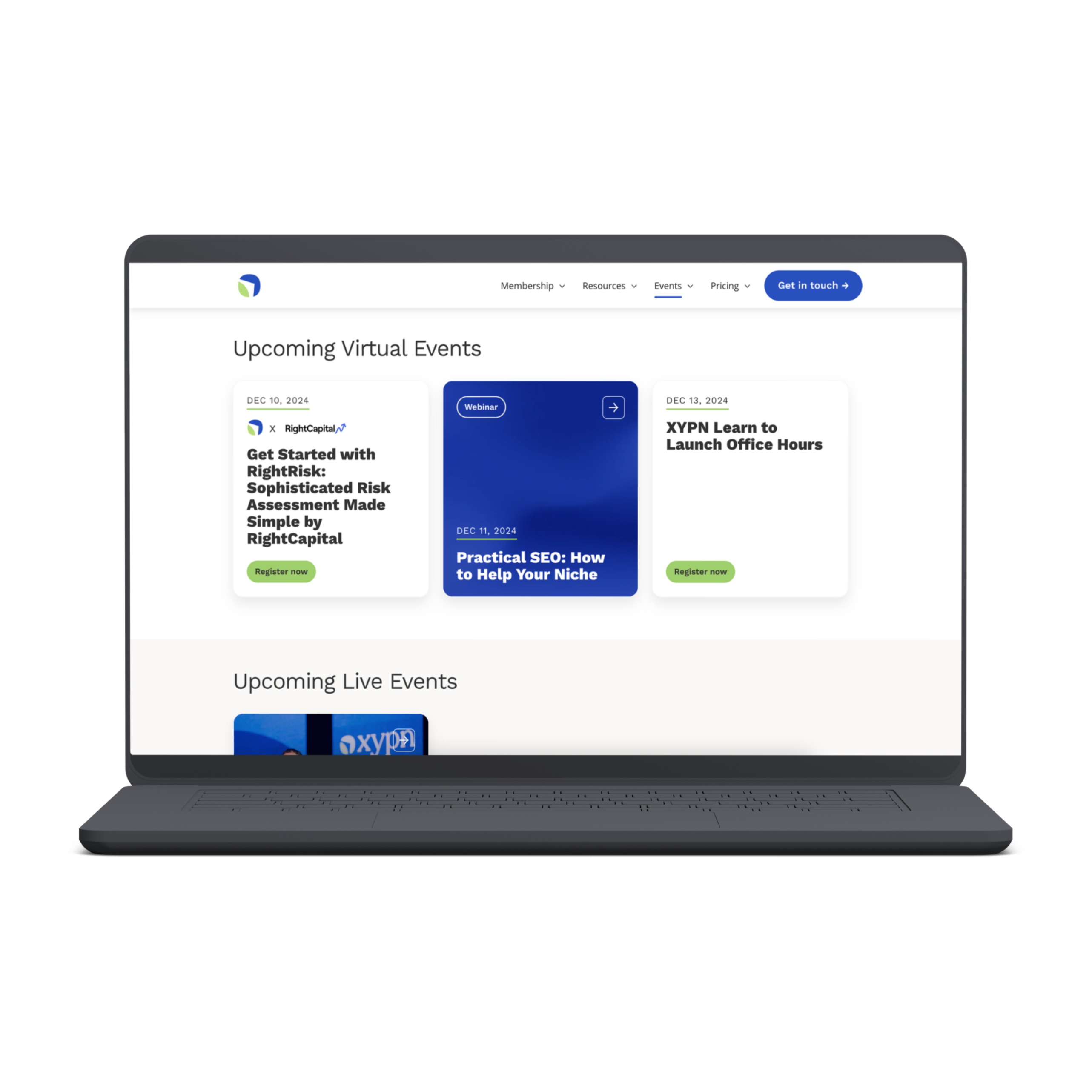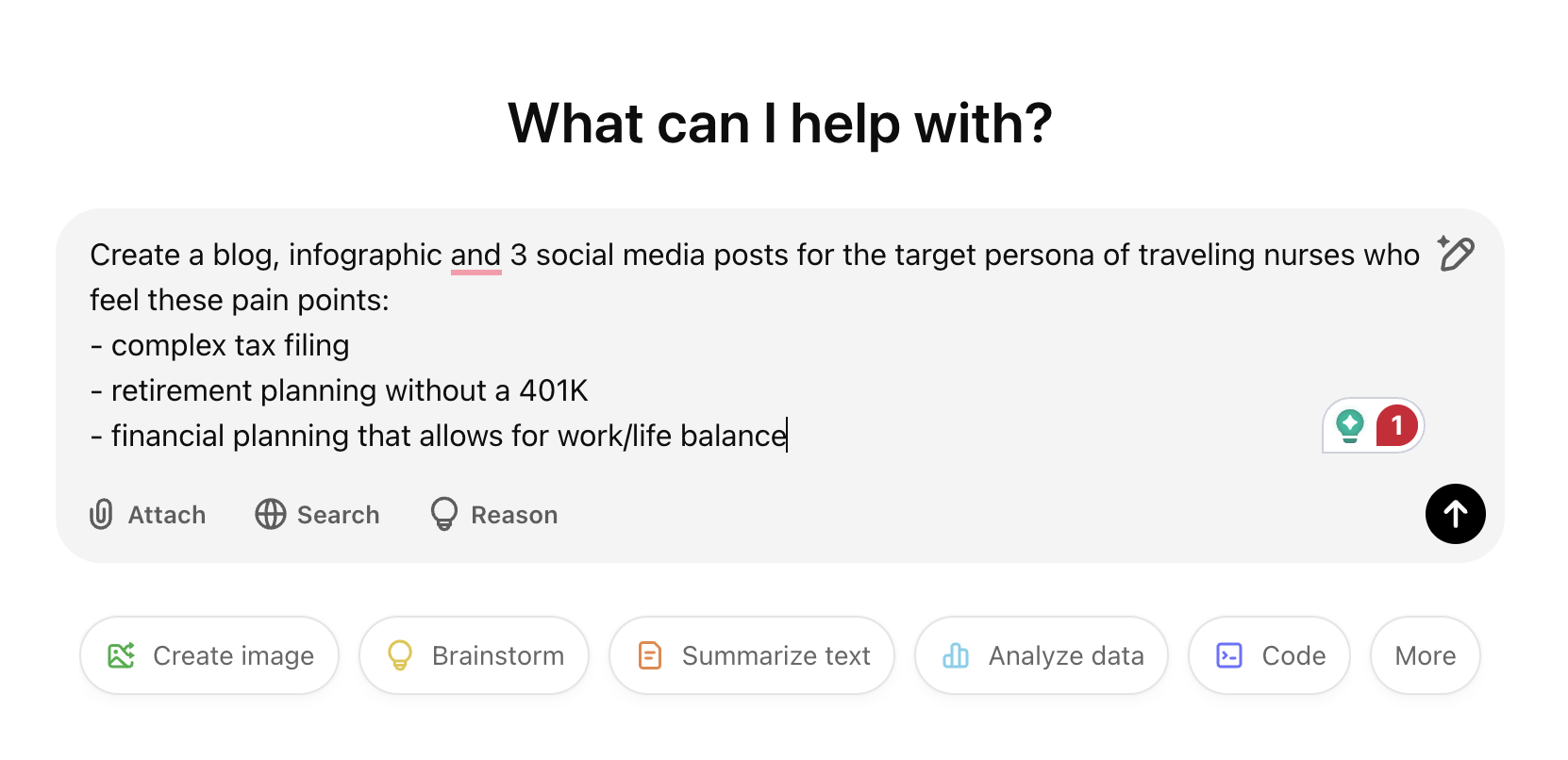Using AI to Create Content
Share this
Marketing your firm can be tricky. Often, there isn’t enough time to dedicate to consistent content creation. The result is content that feels general, lacks personalization, and isn’t delivered on schedule.
AI is a game-changer for content creation for many reasons. It allows you to engage with clients and prospects more effectively by streamlining content creation, improves personalization, and enables data-driven strategies. This resource aims to equip you with the tools to create efficient, personalized, and impactful content.
Getting Started
The first step is to choose the AI tool that suits your needs. Options include:
ChatGPT: Great for general tasks like content creation, brainstorming, and communication.Jasper: Ideal for marketing-focused writing, such as ad copy or blogs.
Writesonic: A versatile tool for creating SEO-optimized content and social media posts.
Once you’ve chosen the right tool, register your email address and verify your account, if necessary. Then, take some time to familiarize yourself with its capabilities.
Crafting the Perfect Prompt
An AI tool, like ChatGPT, generates human-like text based on the input it receives. You provide a question, prompt, or statement, and AI analyzes it, delivering a response that matches the context of your input. The quality of AI-generated content depends heavily on the inputs you provide. Crafting an effective prompt requires six key components.
1. Task
This defines what you want AI to do. It should be clear and direct.
Example: Write six social media captions about the value of fee-only financial planning.
2. Context
This provides the background information that guides AI’s response.
Example: Write six social media captions about the value of fee-only financial planning, targeting young professionals who are just starting to build their financial future.
3. Exemplars
These are examples or samples of what you’re looking for. By showing what “good” looks like, you help AI understand your expectations.
Example: Write six social media captions about the value of fee-only financial planning, targeting young professionals who are just starting to build their financial future. Here’s an example of the style I’m looking for: “Fee-only planning means advice tailored to you, not a sales pitch. Ready to put your financial goals first?”
4. Format
This specifies how you want the output to be structured, ensuring it’s easy to use and aligns with your needs.
Example: Write six social media captions about the value of fee-only financial planning, targeting young professionals who are just starting to build their financial future. Use the voice of a trusted financial expert who’s relatable and approachable. Provide each caption as a bullet point under 200 characters to fit Instagram.
5. VOICE
This defines the personality or role AI should take on, shaping how it communicates the information.
Example: Write six social media captions about the value of fee-only financial planning, targeting young professionals who are just starting to build their financial future. Use the voice of a trusted financial expert who’s relatable and approachable, focusing on empowering readers to take control of their finances.
6. Tone
This sets the emotional or stylistic approach for the response, ensuring it resonates with your audience.
Example: Write six social media captions about the value of fee-only financial planning, targeting young professionals who are just starting to build their financial future. Use the voice of a trusted financial expert who’s relatable and approachable. Provide each caption as a bullet point under 200 characters to fit Instagram. Keep the tone friendly, motivational, and inclusive.
→ PRO TIP
Pro Tip: Create a cheat sheet with snippets of your preferred prompts!

Example Prompt:
"Write six social media captions about the value of fee-only financial planning, targeting young professionals who are just starting to build their financial future. Use the voice of a trusted financial expert who’s relatable and approachable. Provide each caption as a separate bullet point under 280 characters to fit Twitter.
Keep the tone friendly, motivational, and inclusive. Here’s an example of the style I’m looking for: “Fee-only planning means advice tailored to you, not a sales pitch. Ready to put your financial goals first?”"
Some examples of ineffective prompts:
“Write a caption about financial planning.”
The task is unclear. No context or audience is specified, and the format doesn’t indicate what it should be.
“Generate six captions about money.”
The task is too broad. It doesn’t identify who the audience is or the purpose. Lastly, without examples, the AI tool doesn’t know your intended style or tone.
Customize to Your Brand Voice
You can tailor AI to reflect your firm’s unique tone, style, and messaging in a few ways. This ensures that AI-generated content aligns with your brand identity.
You can use a system message before your prompt that defines your content's tone, style, and audience. A system message establishes the AI's behavior, tone, or perspective for the entire conversation. It sets the "rules of engagement" and provides overarching guidance for how the AI should respond to your prompt.
Example: You are a fee-only financial planner who provides clients with clear, concise, and professional advice. Always respond in a friendly and educational tone.
Provide examples of your previous top-performing content and instruct the AI tool to mirror your brand voice and style.
Example: Write a blog post about the benefits of fee-only financial planning. Use this as a reference for tone and style {insert example}.
→ PRO TIP
This is where all your hard brand work pays off. If your website already reflects your brand personality, voice, and tone, you can just plug in your website URL instead of voice and tone instructions.

Creating Niche Specific Content with AI
For AI to generate content that speaks to your ideal client persona, you need to provide clear and relevant information:
1. Understand Your Audience
Identify common goals, demographics, pain points, or questions your clients and/or prospects might face.
2. Add Context
Provide real-world examples or client success stories to make the content practical.
3. Avoid Sensitive Information
Don’t be afraid to incorporate details, but you should always avoid putting sensitive information into an AI tool, including exact client information like account numbers, social security numbers, or any identifying information. Remember, whatever you input into an aggregate tool, it collects and stores it in perpetuity—and you lose control over its output.
Here are some examples of niche-specific prompts:
Blog Post Prompt
Write a 700-word blog post about how fee-only financial planning empowers small business owners to achieve financial clarity and long-term success. Use the voice of a knowledgeable and supportive advisor who understands the unique challenges of entrepreneurs. Provide actionable steps and relatable examples.
Webinar Outline Prompt
Draft a detailed outline for a 45-minute webinar on tax-efficient retirement strategies for high-income professionals. Use the voice of a trusted financial expert and include a breakdown of key topics, such as tax-advantaged accounts, Roth conversions, and maximizing deductions. Make the content practical, easy to understand, and visually engaging with suggestions for slides or graphics.
Email Newsletter Prompt
Write an email newsletter targeting pre-retirees (ages 50-60) about preparing for a secure retirement. Use the voice of a professional yet friendly advisor, and include tips on evaluating savings, understanding Social Security benefits, and creating a withdrawal strategy. Keep the tone reassuring and forward-looking. End with a call to action encouraging readers to schedule a consultation.
Video Script Prompt
Draft a 3-minute video script explaining the difference between fee-only and commission-based financial planning. Use the voice of an educator who simplifies complex concepts for a general audience. Include a relatable opening anecdote, a clear explanation of the benefits, and a motivational closing statement encouraging viewers to consider fee-only planning.
→ PRO TIP
For even more tailored content, try asking AI to generate multiple versions of the same prompt for different formats (e.g., social media captions, blog posts, or infographics). This allows you to repurpose content across platforms while maintaining consistency and relevance.

Streamline Your Content Workflow with AI
AI can streamline your content workflow in many ways. Let’s take a look at a few:
- You could prompt AI to provide you with 5 ideas for blog posts or ask it to write an email to a client that you then review and refine.
- You could input a previously written email and prompt the tool to clarify your messaging or correct any grammatical errors.
- You can pair AI with complementary tools such as Canva or a social media scheduler.
- Have AI refresh your evergreen content, such as reworking a top-performing blog from last year.
- Ask AI to break down long-form content, such as turning a previous blog post into smaller social media captions or email snippets.
Essential steps to include every time you use AI
- Fact-check the output for accuracy and timeliness; AI can and does make mistakes from time to time.
- Maintain originality, ensuring that you aren’t plagiarizing or producing content that is extremely similar to existing content.
A few words of caution before you dive in
With all that AI can do, it is important to be cautious of over-reliance on the tool. I like to use the outputs as starting points and then refine them to infuse them with my authentic voice and details. Becoming a content-creating machine isn’t valuable if your content sounds or feels like a machine wrote it.
Additionally, Google prioritizes original, authentic content and might demote—or not rank at all—content it recognizes as AI-generated. This hurts your organic search traffic and chances to expand your audience if your blog content, for example, doesn't show up in searches. So, if you want to improve your search rankings and attract your ideal clients, be sure to infuse your content with OPA: originality, personality, and authenticity!
Happy prompting!

About the Author
Learning and Development Manager for XYPN. While Sierra works in Membership to manage the learning management system and content delivery channels, she also collaborates with XYPN’s service lines, partnerships, and content marketing teams to ensure internal and external practice management and financial planning content is fully aligned to support firm success.
Share this
- Road to Launch with XYPN Member Alan Skillern, CFP®, MBA
- Coaching for Better Time Management: Prioritizing Organic Growth in Your Daily Routine
- Boost Your Financial Advisory Practice: SEO Strategies and CRM Optimization for Sales Success
- Navigating the AI Revolution: What Financial Advisors Need to Know
- Advisor Blog (692)
- Financial Advisors (221)
- Growing an RIA (99)
- Digital Marketing (87)
- Marketing (84)
- Community (81)
- Start an RIA (76)
- Coaching (72)
- Business Development (71)
- Running an RIA (70)
- Compliance (69)
- Client Acquisition (65)
- Technology (64)
- XYPN LIVE (59)
- Entrepreneurship (56)
- Sales (49)
- Practice Management (44)
- Client Engagement (41)
- XYPN Books (38)
- Bookkeeping (37)
- Investment Management (37)
- Fee-only advisor (36)
- Lifestyle, Family, & Personal Finance (31)
- Employee Engagement (30)
- Client Services (25)
- Financial Education & Resources (24)
- Journey Makers (21)
- Market Trends (21)
- Process (14)
- Niche (11)
- SEO (9)
- Scaling an RIA (9)
- Career Change (8)
- Transitioning Your Business (7)
- Partnership (6)
- Transitioning To Fee-Only (4)
- Social Media (3)
- Transitioning Clients (3)
- Emerald (2)
- Persona (2)
- RIA (2)
- Onboarding (1)
- Sapphire (1)
Subscribe by email
You May Also Like
These Related Stories

The Power of Social Media in Financial Advisor Marketing
Feb 28, 2025
5 min read

The 5-Step Blueprint to Effective Content Marketing
Oct 10, 2022
8 min read





